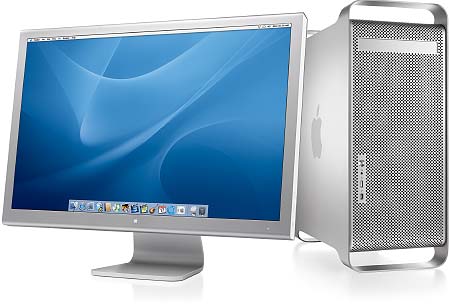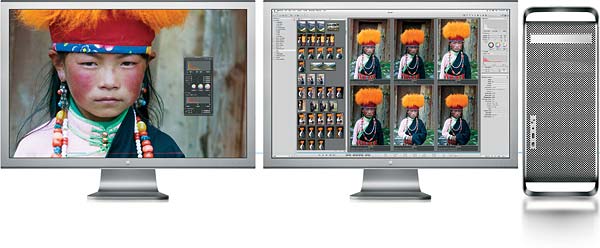Home Search Gallery How-To Books Links Workshops About Contact
Apple
Displays for Digital Photography Apple 30," 23" and 20" Cinema Displays (Courtesy of Apple) LCD or CRT? I used to favor CRTs, but today I prefer the larger working space (square inches) I can get on an LCD. I suggest a calibrator, since LCDs are often designed to look vivid and brilliant instead of accurate. The great news is LCDs don't vary once they're calibrated. With an LCD you can borrow a friend's LCD calibrator once and be OK for a long time. CRTs often come out of the box well adjusted, but will vary over time and Heaven help you if you ever touch the RGB controls without a calibrator, since they're rarely any way to get back to the factory settings. See also my pages on the differences, details and calibration of monitors. Working Space Color spaces are pretty similar among monitors. By working space I'm talking about how many square inches or pixels you have. The more you have on a bigger monitor, the more work you can do at the same time without running out of room. I can work in PhotoShop CS2 or read email or sort photos just fine on my tiny 12" laptop. The reason I'm shopping for a bigger monitor is so I can work in PhotoShop CS2 and Dreamweaver 8 and e-mail and browse the internet and sort photos and take notes in my text editor, all at the same time. When I work on my computer I have a lot going on. Apple Displays Today Apple only offers LCD monitors called "Cinema Displays." Don't let the fancy name scare you: they work on all modern Macs and PCs that have the correct digital connectors. They are extraordinary among LCDs because they don't change their color or brightness as you view them from odd angles. Apple's displays are also better than most because even Apple's smallest is still a big monitor with lots of working space. Apple makes no ordinary 17" 1,280 x 1,024 or 15" 1,024 x 768 monitors for cubicle workers. Apple makes a family of three LCD displays: the big 20," the huge 23" and the gargantuan 30." The prices dropped again in August 2006 to $699, $999 and $1,999. In November 2005 they sold for $799, $1,299 and $2,499. Resolutions are 1,680 x 1,050 (20"), 1,920 x 1,200 (23") and 2,560 x 1,600 (30"). All are about 102 DPI. The rest of the specs are here. They are all excellent. Your choice will be based on how much working space you'd like, and that's based on how much you like to do at the same time. I've always been a fan of the beautiful Apple monitors. You probably can buy an off-brand with the same picture quality for less, but I'd rather stare at sculpture than an ordinary computer monitor. These monitors are the main reason I'm contemplating buying a machine to replace my 12" iBook since the iBook can't drive these. They also talk to your Mac for brightness and power and have a small USB and Firewire hub. The great news is that today it seems that the off brands like HP, Sony, and etc. actually are priced above Apple. This will vary week to week. Another great difference is that the off brands just don't have the size and resolution. Off brands seem to stop at about 1,600 x 1,200 resolution with 1,280 x 1,024 more common in their "big" monitors, which is a fraction of the space and resolution of Apple's mid-level 23" monitor's 1,920 x 1,200. Unlike traditional monitors which, contrary to popular belief, actually take analog VGA inputs from a computer and re-digitize them for display, the Apple Cinema displays take digital DVI inputs directly from the computer. They work on both Mac and windows so long as your windows machine has enough graphics power and a DVI connector or two. Each display is excellent. The image looks the same even when seen from an angle. This differs from laptop displays which look lighter or darker depending on the angle from which they are viewed. Your choice depends on how much you like to do at the same time. Even the 20" is plenty for working in Photoshop. Personally I do everything on a 12" laptop. The 20" display has 1,680 pixels horizontally so there's enough room for two separate panels, one on each side, when web browsing or reading email. I do this all the time on a monitor this size because it gets more done by saving switching among windows. The previous 20" display was introduced January 28th, 2003 at $1,299. The current model was introduced June 28th, 2004 at $1,299 and sold from November 2005 - August 2006 for $799. It dropped to $699 in August, 2006. The newest 20" iMac appears to have the same excellent LCD screen as the 20" monitor. You can get the same pixel count (1,680 x 1,050) in a smaller screen in the 17" PowerBook, although the PowerBook's display brightness varies with viewing angle, just like all laptops I've ever seen. All of Apple's external monitors today incredibly don't change color or brightness if you view them from off-center. 23" Cinema Display and G5 (Courtesy of Apple) The 23" display grows to 1,920 x 1,200 pixels. The advantage to this is that you can grow each of the two windows you may have displayed to wider than the standard 800 pixels. There isn't enough room for three full windows. With 1,920 pixels you can have your mail at 1,024 at which it's happiest and still have 896 pixels left for your web browser. The previous 23" display was introduced March 21st, 2002 and sold for $3,499, later reduced to $1,999 in January 2003. The current model was introduced June 28, 2004 at $1,999. It sold for $1,299 from November 2005 through August 2006. As of August 2006 it dropped to $999. 30" Cinema Display and G5 (Courtesy of Apple) I bought by the 30" display because there is plenty of room for three full 800-pixel wide windows on the screen. Actually there's room for two standard 800 pixel wide windows and 960 for the third. This is the smallest monitor that can handle three full windows, and is also the largest practical computer monitor in existence. Not only can the 30" show three full windows side by side, but each is 1,600 pixels tall. That means a lot less vertical scrolling reading websites like mine where I put a lot on the same page. The 30" display was introduced on June 28th, 2004 at $3,299, sold in most of 2005 for $2,999 and was reduced to $2,499 in October 2005. It was reduced to $1,999 in August 2006. The 30" display isn't for timid computers. It has over five times as many pixels as a standard computer display. It needs a very high-performance graphics card to drive it. That means a new 15" or 17" PowerBook or G5 tower. The 23" and 20" displays work with anything except an iBook. Multiple Displays Two 30" monitors with PowerMac G5 (Courtesy of Apple) My desk isn't big enough for all these displays. All of the Powerbooks and PowerMac G5s make using two displays trivial: just plug them in. With a Powerbook the external display works along with the laptop's display. Your mouse just glides from one screen to the next. It's trivial to set up. You can drag things around as if the two screens are just one huge screen. The current 15" and 17" PowerBooks work with up to a 30" display; the 12" powerbook is limited to the 23" display maximum. The PowerMac G5s also all work with the 30" display and a second display up to 23" at the same time. If you want to run two 30" displays simultaneously you'll need an optional hotter graphics card. This changes with time, so be sure to read the fine print at Apple's site before you order. NEXT > > SUMMARY and WHERE I'D BUY BACK: DESKTOP MACS Return to top of COMPUTER RECOMMENDATIONS |






